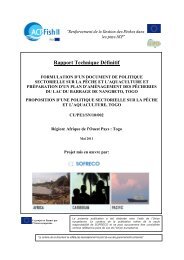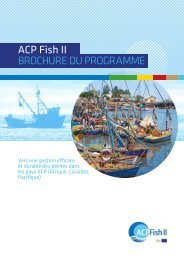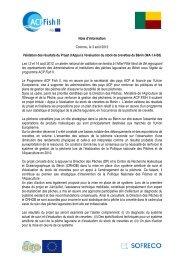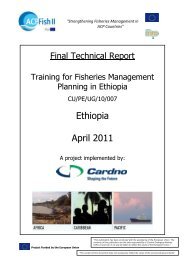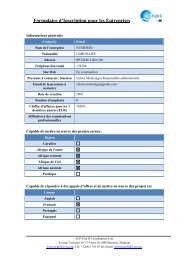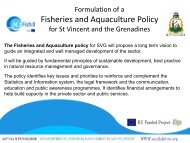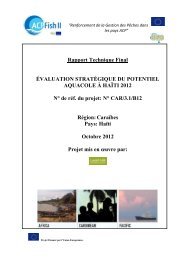Final Technical Report part 3 - ACP Fish II
Final Technical Report part 3 - ACP Fish II
Final Technical Report part 3 - ACP Fish II
Create successful ePaper yourself
Turn your PDF publications into a flip-book with our unique Google optimized e-Paper software.
Elaboration of an aquaculture development strategy forst. kitts and nevis – Aquaculture situation appraisalAfter stocking the sea cages the land based facility could either lay idle or some minor volumefish could be kept for on growing also in the tanks – for ad hoc farm gate sales. Later whenharvesting fish from the cages they could also be brought back to the tanks to have a “live fishstorage”, because when fully grown to market size they do not need to be fed much (or anythingif only few days) – again to have a buffer for “fresh fish” for sales – such as e.g. if preparing thesales of 3,000 freshly harvested fish for the next cruise boat arriving.There are endless combinations and specialisations, which could be applied depending on thespecies and market focus and the personality and competitive edge of the farmer/investor.One final specialisation to mention is that the land based farm could also be operated as aquarantine unit – i.e. importing newly weaned fish fry – or even newly hatched fish larvae – andthen grow them for sales to other farmers. This is a very high valued product – very high profitmargins - but of course would need very skilful technical management – and it would need themarket (the other farmers).As this is a very important strategic facility for the development of the sector - to be in control ofthe quality of the juveniles for stocking - it could in the start be operated as a fully governmentalfacility or a PPP which eventually could be fully privatised (when the market has developed).Eventually SKN should develop at least one ‘all inclusive’ hatchery. Again – the pristine oceanicwater surrounding SKN and far away from marine fish farming would be a strong competitiveedge in producing high quality marine fish juveniles for the whole Caribbean region. TheTaiwanese would claim that the water is too clean – and does not have enough nutrients for theSE Asian extensive hatchery model – but if necessary this can be added. Most importantly thereis no pollution and disease germs, which the Taiwanese have as a constraint in their preferredsetting.If thinking ahead in the sector development the hatchery should be situated on the AtlanticOcean side of the islands as the main Caribbean current comes from the East-Southeast – andthe future cage farming will take place in the Caribbean Ocean.5.2 The technical setup of the SKN aquaculture modelA rule of thumb for a newcomer in aquaculture is to use PROVEN technology. Don’t be a “guineapig” for some equipment company.This is why it is NOT suggested to start with submersible cages for all-year-production in the sea.Even some structures are claimed to have survived hurricanes it is an unnecessary risk to takewhen there are already proven technologies available – but only managed in a different mannerthan normal. The submersible cage solutions are a<strong>part</strong> from expensive equipment solutions alsoexpensive in operation. Many procedures have to be carried out by divers – and the service boatshave to be of a certain large size.5.2.1 Land based facilityTo start with the land based facility – which is illustrated in a generalised model in Figure 32.This project is financed by the European Union Project implemented by pg. 65RTF pg. 137/204





